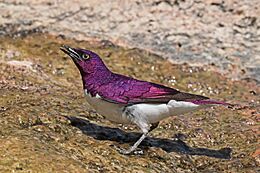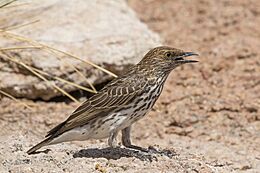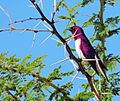Violet-backed starling facts for kids
Quick facts for kids Violet-backed starling |
|
|---|---|
|
|
|
| Male | |
|
|
|
| Female both C. l. verreauxi Damaraland, Namibia |
|
| Conservation status | |
| Scientific classification | |
| Genus: |
Cinnyricinclus
|
| Species: |
leucogaster
|
| Synonyms | |
|
Turdus leucogaster Boddaert, 1783 |
|
The violet-backed starling is a beautiful bird. It is also known as the plum-coloured starling or amethyst starling. This small bird is about 17 centimeters long. It belongs to the starling family. It is the only bird in its special group, called genus Cinnyricinclus.
You can find these birds in the woodlands and forests of sub-Saharan Africa. They usually stay in trees and rarely go on the ground. Male and female violet-backed starlings look very different from each other.
Contents
About the Violet-backed Starling
The violet-backed starling was first described in 1775. A Dutch scientist named Pieter Boddaert gave it its scientific name, Turdus leucogaster, in 1783. The bird's special group, or genus, Cinnyricinclus, was created later in 1840.
The name leucogaster comes from old Greek words. Leukos means "white" and gastēr means "belly". This describes the bird's white belly.
Types of Violet-backed Starlings
There are three main types, or subspecies, of the violet-backed starling:
- C. l. leucogaster: Found from Senegal to Ethiopia and Tanzania.
- C. l. arabicus: Lives in east Sudan, northwest Somalia, and the Arabian Peninsula.
- C. l. verreauxi: Found from southern DR Congo to South Africa and Mozambique.
What Does It Look Like?
The violet-backed starling is about 18 centimeters long. Males and females look very different. This is called being sexually dimorphic.
The male bird has a shiny violet head and back. Its belly is pure white. The female bird looks more like a thrush. She has brown feathers on her back with bold streaks. Her white belly also has many streaks. Both male and female birds have bright yellow eyes. They also have black beaks and legs.
Where Do They Live?
The violet-backed starling is common in many parts of Sub-Saharan Africa. You won't find it in very dense rainforests. You also won't see it in the driest parts of southwestern Africa.
These birds prefer open woodlands. They also like forests along rivers and forest edges. Sometimes, they live in clearings within forests. In places like the Chyulu Hills in Kenya, they can be found high up. They live at altitudes up to 2,100 meters.
Behaviour and Life Cycle
Violet-backed starlings eat different kinds of food. Their diet includes fruits, seeds, and insects. They sometimes catch insects in the air, just like flycatchers do. They mostly look for food in the treetops. They rarely search for food on the ground.
When it's time to build a nest, they often choose a crack in a tree. The nest is usually just a few meters off the ground. They use green leaves and even animal dung to build their nests.
The female bird lays two to four eggs. The eggs are pale blue with reddish-brown spots. She sits on the eggs for about 12 to 14 days. This is called incubation. The male bird helps feed the baby chicks. The young birds are ready to leave the nest after about 21 days.
Images for kids







